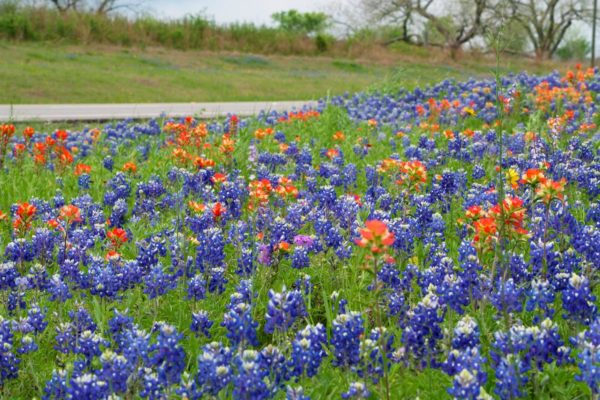AUSTIN, Texas – The spring wildflower season in Central Texas may come early this year and be spread out over several months rather than a rush during March and April, say experts at The University of Texas at Austin’s Lady Bird Johnson Wildflower Center.
The area received ample fall and winter rains to promote good wildflower displays, and warmer than usual weather in February is leading to some wildflowers blooming earlier.
“Hold onto your hat and fasten your seatbelt,” said Andrea DeLong-Amaya, director of horticulture at the Wildflower Center. “Wildflower season is taking off faster than you expect.”
Most of the wildflowers that bloom in the spring are dependent on fall precipitation followed by sustaining winter rains. Such iconic spring-bloomers include the beloved Texas bluebonnet (Lupinus texensis), Indian paintbrush (Castilleja indivisa), phlox, verbena and a rainbow of other colorful flowers.
Higher temperatures in January and February pushed some plants to bloom early. The fragrant purplish blooms on Texas mountain laurel (Sophora secundiflora), for instance, are triggered by the warmth and are beginning to show around Austin.
“When a cold snap happens, bluebonnets are rarely damaged,” DeLong-Amaya said. “But when we have warm spells as we have, and plants such as mountain laurels bloom, they are vulnerable to damage during a late hard freeze. We’ve had freezes in late March and early April, and if things are blooming by then, we can lose a lot of flowers for the season.”
The National Oceanic and Atmospheric Administration’s three-month forecast predicts warmer than average weather for Central Texas, but cold fronts and freezes can still occur.
Besides weather, factors such as soil quality and land management practices (e.g., burning, mowing and grazing) determine what blooms where. Bluebonnets tend to thrive in disturbed sites, so mowing and grazing can promote robust growth of the state flower.
“Generally speaking, spring-blooming annual wildflowers are encouraged by grazing and mowing because the competition from perennials and grasses is knocked back,” DeLong-Amaya said. “A fire or flood, or even vigorous gardening, can open up space and make it more conducive to annual wildflowers.”
What’s blooming in Central Texas
At the Wildflower Center, bluebonnet plants are in great shape, and a few blooms are already showing. The handful that have flowered are ahead of a season that typically peaks in April. It’s a little early to tell whether Indian paintbrush, often found among bluebonnets but later to bloom, will have a banner year as they did in 2016.
DeLong-Amaya predicts a strong year for pink evening primrose (Oenothera speciosa). These dainty pastel flowers, often called “buttercups,” have bloomed inconsistently during the past several years, sometimes sparsely dotting roadsides and other times strikingly dominating great patches from the airport through the Hill Country.
She also noticed spiderworts near Lady Bird Lake, bursting with purple color notably early in the year. “The extra warmth from downtown probably pushed those blooms out a little faster,” she said.
Other flowers are adding color right on schedule, such as the fragrant, trumpet-shaped yellow blooms of Carolina jessamine (Gelsemium sempervirens), a vine that can be seen ascending the Wildflower Center’s seed silo and filling in trellises in the Family Garden. Other plants just beginning to put on a preseason show include elbow bush (Forestiera pubescens), golden groundsel (Packera obovata) and agarita (Mahonia trifoliolata). Overhead, redbuds (Cercis canadensis) are beginning to produce pink blossoms, boldly contrasting the late winter skies.
DeLong-Amaya has also noticed a strong presence of flowering baby blue-eyes (Nemophila phacelioides) east of Austin. She thinks they will have a good turnout in areas with sandy or loamy soil.
Elsewhere in Texas
In the Coastal Bend (central Gulf Coast), Kris and Ray Kirkwood of the Native Plant Society of Texas (NPSOT) reported last week that Drummond phlox (Phlox drummondii) and greenthread (Thelesperma filifolium) are already “going strong,” with blue curls (Phacelia congesta) just beginning to bloom.
“They should look wonderful in two weeks,” said Kris Kirkwood, who made predictions based on what was growing at the Rockport Cemetery after noticing her own Texas babybonnets (Coursetia axillaris) had begun to bloom.
At the Padre Island National Seashore, where it has been warm with little rain, Neil Adams (also of NPSOT) has observed the fiery flowers of Indian blanket (Gaillardia pulchella) and the small white blooms of Corpus Christi fleabane (Erigeron procumbens). He has also seen flowering ground cherry (Physalis cinerascens var. spathulifolia), blue-eyed grass (Sisyrinchium biforme) and camphorweed (Heterotheca subaxillaris).
Since early February, there have been reports of Big Bend bluebonnets (Lupinus havardii) blooming in West Texas, which DeLong-Amaya said is not surprising. Those bluebonnets tend to show earlier, and many of the western blooms have come and gone by the time Central Texas is hitting peak season.
“It promises to be a good wildflower year along the river since we got winter rain. That could all change if we get a late cold spell,” said Karen Little, nursery manager at Sul Ross State University in Alpine. “The winter was mild in the Davis Mountains, so the spring wildflower season should be good there as well.”
In Lubbock, landscape designer Olivia Sievers Ross said wildflower season is always much later than in the rest of Texas, but recent rains should encourage ample blossoms. “It’s a little easier to forecast once we know if we will have a late freeze after the wildflowers have started blooming,” she said, but she notes that it’s been a tame winter to date.
Learn more
As the season progresses, Texans and visitors can look for updates about what’s blooming on the Wildflower Center website (wildflower.org) and social media channels (Twitter, Facebook and Instagram), or come to the center in person to experience and learn about the native plants that line roadsides, pop up in neighborhoods and sometimes “volunteer” to inhabit maintained gardens.
Note to Editors:
Photos of previous years’ wildflower seasons are available from the Wildflower Center.




